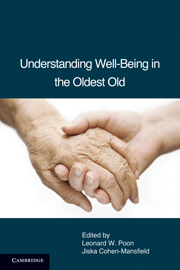Book contents
- Frontmatter
- Contents
- List of Tables
- List of Contributors
- Foreword by Carol D. Ryff
- PART I THEORY: NEW HORIZONS IN WELL-BEING RESEARCH
- PART II PARADISE LOST: BETWEEN TRAUMA AND HAPPINESS
- 6 Does Trauma Linger into Old-Old Age? Using the Holocaust Experience as a Paradigm
- 7 The Impact of Life Events on the Oldest Old
- 8 Posttraumatic Stress Disorder and Its Treatment at Late Life
- PART III PATHWAYS AND GATEKEEPERS: MODERATING, MEDIATING, AND PROXIMAL PROCESSES
- PART IV SIGNPOSTING PARADISE: MEASUREMENT OF WELL-BEING
- Index
- References
8 - Posttraumatic Stress Disorder and Its Treatment at Late Life
Published online by Cambridge University Press: 05 August 2012
- Frontmatter
- Contents
- List of Tables
- List of Contributors
- Foreword by Carol D. Ryff
- PART I THEORY: NEW HORIZONS IN WELL-BEING RESEARCH
- PART II PARADISE LOST: BETWEEN TRAUMA AND HAPPINESS
- 6 Does Trauma Linger into Old-Old Age? Using the Holocaust Experience as a Paradigm
- 7 The Impact of Life Events on the Oldest Old
- 8 Posttraumatic Stress Disorder and Its Treatment at Late Life
- PART III PATHWAYS AND GATEKEEPERS: MODERATING, MEDIATING, AND PROXIMAL PROCESSES
- PART IV SIGNPOSTING PARADISE: MEASUREMENT OF WELL-BEING
- Index
- References
Summary
ABSTRACT
We discuss psychological trauma, notably Posttraumatic Stress Disorder (PTSD), at late life, paying special attention to what is distinctive at advanced ages. PTSD is fundamentally a diathesis-stress disorder. The role of aging as a mediating or moderating influence in the expression of psychological trauma is highlighted, especially as it applies to the oldest old. As a general position, older victims tend to be no more or less vulnerable or reactive to trauma than younger victims despite increasing stress rates at older ages. That said, older age presents differences in both the experience of life and in the integration of trauma into one's life narrative. In examining aging as it relates to trauma, we first discuss the biological sequelae of trauma in PTSD, as well as the effects of a biological core feature of aging: memory impairment and overall cognitive decline. PTSD is then considered as it relates to the understanding of the self in aging. Later, we elaborate on relevant PTSD models, especially the Developmental Adaptation and Changes of Adaptation models. We end with an examination of PTSD interventions originally developed for younger age groups and review the empirical support for older adults.
- Type
- Chapter
- Information
- Understanding Well-Being in the Oldest Old , pp. 111 - 148Publisher: Cambridge University PressPrint publication year: 2011
References
- 1
- Cited by



